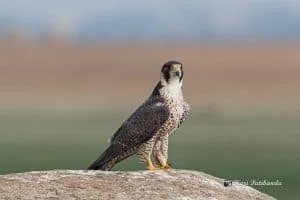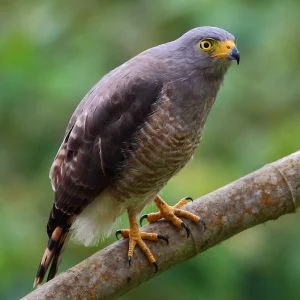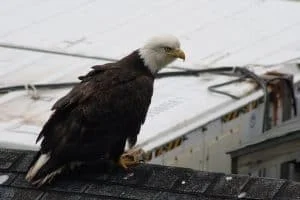The difference between Hawks, Falcons, and Eagles can be difficult to spot for bird watchers of all experience. This article seeks to define the 8 obvious distinctions between Hawks, Falcons, and Eagles , in order to provide a clearer guide to help you identify between them.
Their attributes are divided up into categories, from size, build, color, and behavior to diet, flight pattern, and location.
This knowledge will help you take into consideration the various factors that make these birds unique and hopefully equip you with the relevant information needed to identify what bird you are looking at.
There are many species of hawks, falcons, and eagles that may have further unique elements to them, but this article compiles the basic differences needed in order to draw easy comparisons between the three birds. Let’s start with the basics pictures and sounds:



Sound
Size
Comparing these birds according to size may be one of the easiest ways to form distinctions between them.
Although all birds of prey are generally large and intimidating in size and demeanour, size is in fact one of the primal and apparent ways of differentiating between these particular birds.
Eagles are undoubtedly the largest of the three, followed by hawks and then falcons, which are perceived the smallest.
Remarkably, the wingspans of eagles, such as the Bald Eagle and the Golden Eagle, are measured at up to 7 feet, compared to hawks who have an average wingspan of 4 feet, and falcons whose wingspans are under 2 feet. Certain species of falcon can in fact be very small, some weighing under 1kg.
The smaller size of the falcon, compared to the larger hawk and eagle, makes it more desirable for the sport of falconry. The average eagle is around 36 inches long and can weigh up to 7kg. Similarly, the average hawk size is around 22 inches, weighing around 2kg. Falcons, on the other hands, measure at about 14-19 inches long.
It is not enough, however, to rely on size as the only distinguishable factor between the birds as, for example, various species range in sizes – and some species of falcon can be larger than small hawks. Red-tailed hawks are also bigger than the particularly small species Eagle, the Australian Little Eagle. Therefore, measurement alone is not sufficient enough to be a sole distinguishable trait, and other factors, such as location and species attribution, must come into play. Further, identifying these birds whilst they are flying at a distance in the air would mean that any assumption of these birds’ size would not be entirely accurate.
Build
Similar to their size, these birds have different builds that helps birdwatchers identify between them.
Falcons have a bullet-shaped body, which is rather unique and easily identifiable when they are perching. Their wings are long, narrow and sharp, as well as their toes which are also clawed and pointed. Their thin, narrow wings enable them to fly at a great speed.
Eagles, on the other hand, have long and broad wings and particularly large feet with sharp nails. They have large heads and particularly large, hooked beaks that assist them in hunting for prey. Eagles are notably taller and stronger than hawks, weighing sometimes 10 pounds more than the average hawk. Most eagles are muscular and hefty, and they have very strong tall legs. They are often referred to as the king of birds.
Hawks, on the other hand, are muscular but are not nearly as muscular as eagles. Notably, hawks have sharp talons and curved beaks, which are key factors to look out for. Hawks have shorter wings than eagles and falcons but have distinctively longer tails.
Colour
Colour is another key factor to consider when differentiating between these birds, despite them all appearing to have similarly coloured earth-toned feathers at first glance. There is no denying, however, that there are key colour attributions and patterns unique to each bird that is useful in identifying the species.
In regard to the colour of their bodies, hawks are likely white and brown in colour, whereas falcons demonstrate more grey colours and eagles have more golden-yellow and dark grey pigments.
Eagles have a much greater unique colour variation and have vibrant yellow beaks that are often easily spotted in flight. Their feathers also have a golden sheen from the head and down the back that is unique and eye-catching.
Hawks and falcons are rather similar to each other, but notably, hawks have brown cheeks whereas falcons have white cheeks. These cheek stains are a great way to identify the species. Another element to consider is the striping on the belly – falcons have stripes that extend down the entirety of the belly, whereas hawks only have a whiteish band at the base. Some species of hawk, such as the Red-tailed Hawk, have further distinguishable features – namely their red tails – which may help with identification. Most falcons also have grey tufts of hair that look like sideburns, named malar stripes, which is another key attribute to look out for.
Diet
When it comes to hunting, these birds share a vicious and menacing practise of accessing their prey that is common to other carnivores alike.
Their diets are very similar, which means that eating habits may not be entirely helpful on its own to help individuals identify their species. But there are, however, some noteworthy variations.
Eagles in particular are dauntless when it comes to foraging, often hunting prey larger than them in size, but most commonly they are drawn to snakes, rabbits and other birds – often harassing other birds and eating from garbage too. Particular species of sea eagles would also eat fish, dead or alive, as well as other marine creatures.
Falcons are particularly skilled in hunting too, because of their immense flying abilities. They often eat other birds and critters whilst in flight, or they shoot down towards prey from the sky. They are also very talented at catching pigeons in cities and towns, which is a key element for birdwatchers to look out for. Similar to Eagles, they would also eat snakes and rabbits, as well as other creatures alike. Hawks have similar dietary habits to eagles and falcons, often found hunting for rabbits, snakes and mice. In fact, they also eat lizards and fish near water-based environments.
Behaviour
There are many similarities in the behavioural patterns of these birds, but there are also subtle distinctions that are integral to differentiating between them. One of the most valued characteristics of hawks is their incredible eyesight.
In fact, all three of these birds are known to have incredible eyesight, but there are differences in ways they use their eyesight to their advantage.
Hawks are able to spot their prey from around 100 feet away and can identify various colours, unlike most other animals. Often, they are found in flocks, known as a kettle of hawks. They may appear in their thousands, often combining the advanced eyesight of the group to hunt for prey amongst various shrubbery and locations in the daytime.
Eagles are also most active in the day; however, they are mostly found alone or occasionally in pairs, too. Eagles too have excellent eyesight, up to 8 times stronger than a human. They hunt for their prey on the ground, and combine their immense vision with their impeccably vicious strength to capture and devour their prey.
Falcons are very aggressive in their quest for food – diving fast and powerful to grab their prey. Unlike hawks and eagles, they capture and kill their prey with their predominantly sharp beaks, as opposed to their feet – which is a key distinction. They too are most active during the day, again with the aid of excellent eyesight.
Flight Pattern
Birdwatchers are most likely going to spot these birds in flight, which is why distinctions in their flight patterns is one of the most crucial elements to help identify between the three.
There are in fact differences in the ways these three birds fly.
Hawks in particular are slower flyers, often gliding across the air smoothly. A key thing to look out for is when their wings are outstretched, they have notable curves on the ends of their wings that look like fingers – this is most noticeable during flight and can certainly help identify the birds.
Falcons are perhaps the most celebrated flyers; they have extremely long wings that help them fly at incredibly high speeds. The Peregrine Falcon can fly around 60 miles per hour, and dive at an astonishing 200 miles per hour, making it the fastest moving bird on the earth.
Their incredible wings are narrow and pointed, particularly during flight, which enables them to change direction abruptly. Another key distinction is the way they flap their wings rapidly, whereas hawks flap their wings slowly because of their large surface area.
Unlike hawks, they do not glide all that often, and only do so when they travel at very short distances.
Eagles are a remarkable sight in the air, typically soaring and gliding through the sky with their wings forming a distinguishable ‘V’ shape and flapping in a slow wingbeat. Similar to hawks, eagles have separated wingtip feathers that look like fingers; however, they are much less defined.
Location
Generally, location is a determining factor of which bird is likely spotted in your area. These three birds, however, are in fact widespread across much of the world. In many countries, there are parks and centres that care for these predatory birds and offer the chance for the public to visit them.
They can also very commonly be found in various wild landscapes across the world, and although all three of these birds can be spotted in similar regions, there are particular locations and habitats that each bird favours.
Wild hawks are most commonly found in North and Central America. They are various species of them, however, across much of Europe, Africa and Australia. In terms of habitats, hawks are most often attributed to many areas, namely forests, mountains, rainforests, deserts and along coasts.
Like hawks, eagles are vastly distributed all over the world, too. From the topics of South America and Asia, to dryer climates in Australia and North America – these birds are very commonly spotted. They enjoy a variation of habitats, from dry mountainous lands and deserts, to rainforests and grasslands along rivers. Eagles are also very common to Western U.S.
Falcons too can be found across much of the world. They are most popularly attributed to the Americas but are also residents of Africa and Europe too. Some of their various habitats include forests, wetlands and coastal areas, to name a few. They are likely to be found on high perches, waiting for the opportunity to catch their prey.
